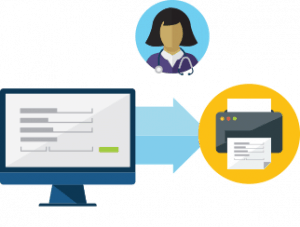
The electronic version of patients charts are the electronic health records (EHRs) that facilitate the availability of patient information to the physicians and other healthcare providers. The electronic health records work on a real-time basis and are patient-centered that help in providing patient information instantaneously and securely. The EHR systems cover a broad spectrum of things and not just the patient history. They have information regarding a patient’s past medical details including diagnoses, medication, treatments, laboratory & radiology reports, allergies etc. The most prominent aspect of EHR systems is that they can be accessed and managed by any provider who is authorized and the data from these systems can be shared with other authorized healthcare providers and laboratories etc. across different locations. To implement such an amazing system, it is essential that the healthcare providers including physicians understand certain things about implementing the EHRs.
Comprehensive approach: It is understood that the EHRs get their power from the totality of information they have and provide to the authorized people when needed. The patients are benefitted to the most extent when their data is available across all specialties instead of a single specialty. If a healthcare provider opts for specialty focused EHR solutions, he/she will be able to document the procedures to the minutest of details. However, if the healthcare provider has to access other specialty details, he/she may not be able to do that due to the system inefficiencies. On the other hand, comprehensive EHR solutions deal with the patient information in totality and facilitate communication of information to physicians of any specialty.
Gain physician’s trust: One of the toughest tasks in implementing EHR solutions is gaining physicians’ trust and making them use it. However, it has to be done and once they understand the benefits of EHRs they don’t mind taking some trouble to enter the data into the system. With EHRs in place, physicians don’t have to waste time for the arrival of a patient’s records to start procedures as they are available at their fingertips. Also, they are satisfied that quality care is not delayed due to unavailability or delay in laboratory and radiology reports that are crucial in the decision making of the treatment course.
Other employees: The other employees like medical assistants etc. also need to be brought on board to use this system as they are the people who do a lot of documentation and they need to be made aware of the benefits of using these systems. They have to be guided on identifying gaps in preventive care and address them effectively.
Continuous support: It has to be understood by each and everyone involved in using these systems is that to reap the optimum benefits of EHRs it is necessary that training is essential to understand the new technology and ongoing technical support is provided as and when required.
Implementation of EHR solutions is a matter of huge investments in terms of financial and human resources. Although it takes a few years’ time to show results, implementing EHRs is beneficial to all and the process can be made less cumbersome by taking into consideration the points discussed here.
